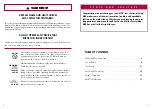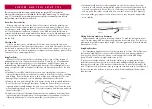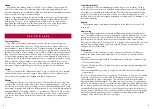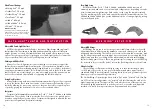
6
7
These are general tips for setting up and caring for your MSR
®
tent or shelter.
More specific instructions are included for Fast & Light
®
models on p. 12 and Wings
™
on p. 13. For detailed setup instructions on your specific tent model, please refer to
the Tyvek tag sewn into the tent stuff sack.
Know Your Tent or Shelter
Before going on a trip, learn the basics of your tent or shelter by pitching it at
home. Now is the best time to attach your guy cords and make sure that you have
everything you need. Being familiar with your tent or shelter will help if you have to
set it up in the dark or in adverse conditions. Some MSR tents and shelters are in-
novative, hybrid tarps and single-wall shelters that do not set up like traditional tents.
So it is especially important to practice setting up these shelters before heading out
into the field.
Selecting a Site
Select a site that is level, will drain well if it rains, and is protected from wind
and other elements. Clear the area of sharp stones, sticks, and other debris, both for
comfort and to protect your floor. Avoid low spots where rain can pool or where you
see watercourses. In order to minimize your impact on the environment, please follow
“Leave No Trace” camping guidelines.
Using Tent Poles
Many of our Fast & Light shelters use trekking poles or guy-out lines instead of
traditional tent poles to support the shelter structure. Please see p.12 for additional
Fast & Light setup instructions. Most of our Expedition
™
and All-Season
™
tents use
traditional-style, lightweight DAC FeatherLight
™
tent poles. These ultralight poles are
strong enough to provide a lifetime of trouble-free use if properly cared for. For best
results:
• Handle poles carefully. Unfold them one at a time, starting from the center to
reduce the length the shock cord needs to stretch to fold the poles. When unfolding
and folding, do not allow the shock cord to pull the pole ends together. This can
damage the pole ends and result in breakage when the pole is tensioned.
• Always push your poles through the pole sleeves, during both setup and takedown.
Do not pull your poles through the sleeves. Pulling the poles will cause sections to
separate and potentially damage the pole or your tent fabric. Don’t force the poles
when threading through pole sleeves. If you feel resistance, find the snag and work
the poles through it.
• A light coat of silicone lubricant will prevent corrosion and keep poles from freez-
ing in extremely cold temperatures. In strong-saltwater environments, use silicone
frequently and rinse poles in fresh water when you return from your trip.
• In extremely cold weather or after extended use, the shock cord can lose some
elasticity. In cold weather, simply pull the end pole section quickly back and forth
to create enough heat to loosen the cord. If more tension is needed, unscrew the
end tip, pull a few inches of cord and, tie a new knot in the cord.
(See Figure 1.)
• In severe winds, guy-out your tent to relieve stress on your tent poles and provide
more stability.
Placing Poles into Stake Loop Grommets
Fabric expands and contracts in varying climates. To pitch the tent tight in a vari-
ety of climates, many MSR tents have two grommets in the stake loops. Use the outer
grommet in dry climates when fabric is tight. The inner grommet is for humid climates
when fabric is looser.
Using Guy-Out Lines
It is important to tightly tension your shelter via the guy-out lines. This will increase
the structural stability of your shelter, reduce fabric droop, and prevent rainwater
from pooling. Guy-out lines can also be used instead of poles with MSR Wings
(see p. 13)
and some Fast & Light shelters
(see p. 12)
.
To guy-out your shelter, attach a cord from the shelter’s guy-out grommet through
the metal tensioner. Pass the cord around the stake and back through the tensioner,
keeping the curved side of the tensioner toward the tent. Tie a knot at the end of the
cord. To tighten cord, pull the tensioner up along the cord and release.
(See Figure 2.)
This process can also be done in reverse to allow for adjustability at the tent rather
than the stake.
S H E L T E R A N D T E N T S E T U P T I P S
Figure 1
Figure 2



























